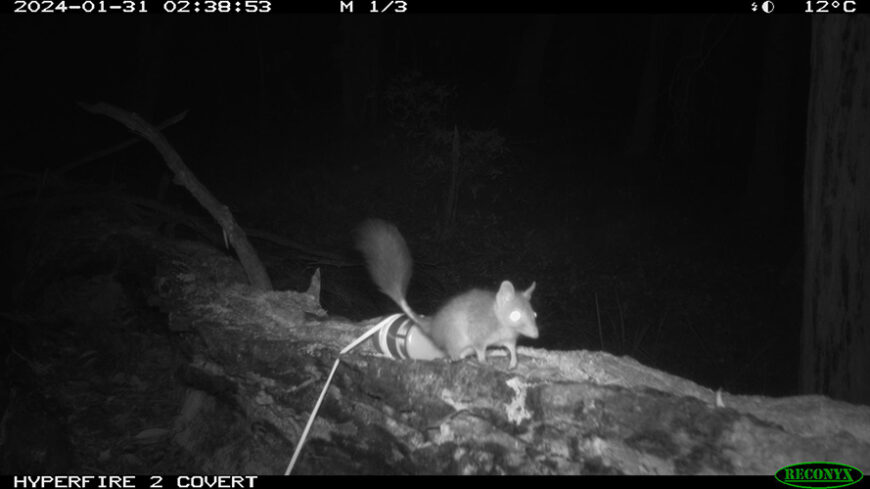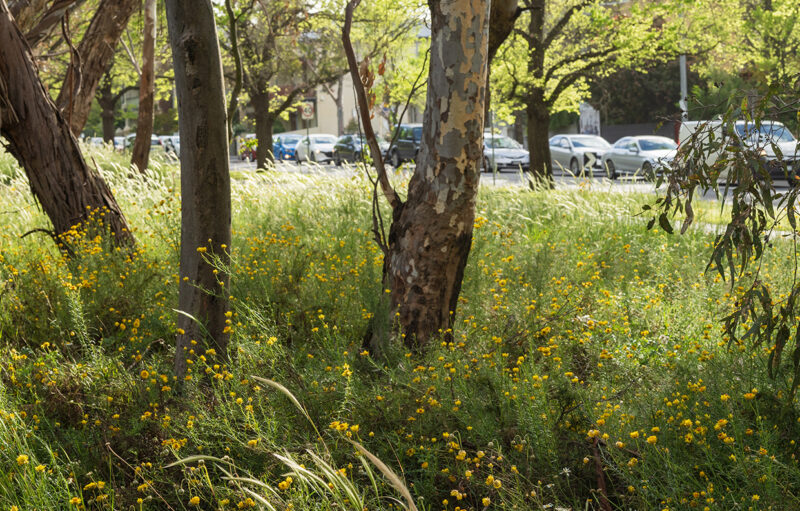PARK WATCH Article June 2024 |
Dr Sera Blair, Naturewatch Coordinator, on looking for Mountain Skinks and Brush-Tailed Phascogales in the Future Wombat-Lerderderg National Park
From November 2023 to May 2024, the NatureWatch team returned to Wombat Forest to support our work to end rogue logging and improve protection for wildlife living in the forests.
We partnered with Wombat Forestcare, aligning our citizen science program to their search for two very interesting, threatened critters: Mountain Skinks and Brush-tailed Phascogales.
Mountain Skink
Mountain Skink (Liopholis montana) are difficult to survey as they zip under protective plants or rocks as soon as they hear you approach and then wait a while before re-emerging.
With the help of Wombat Forestcare’s Gayle Osborne, we searched in areas of typical Mountain Skink habitat. We started by walking around slowly, looking and listening for any skink movement. As they are relatively large, we saw potential Mountain Skinks a few times, but they moved so quickly it was difficult to confirm an ID.
So, we set up a series of cameras on the ground, directed towards potential skink holes tucked in the sides of rocky mounds and embankments. Rather than take photos, the cameras were set to record 10 second videos when triggered by movement. Our assumption: while difficult to photograph with good enough clarity for identification, a short video may offer the chance to assess body size and colouration.
It worked! We recorded two videos of Mountain Skinks in one area, along with an array of other animals such as Agile Antechinus, Bush Rat, Swamp Wallaby, Eastern Grey Kangaroo, Ring-tailed Possums, Echidna, Crimson Rosella, Grey Currawong, Grey Shrike-thrush, Red-browed Finch, Superb Fairywren, White-browed Scrubwren and Yellow-tailed Black Cockatoos. Wombat Forestcare’s habitat assessment was spot on.
These Mountain Skink records are being verified by experts. If confirmed, they’ll be added to other sightings that are challenging the destruction of their habitat in areas of storm clean-up or planned burns.
Brush-tailed Phascogale
Brush-tailed Phascogales (Phascogale tapoatafa) prefer open, drier forests with plenty of hollow-bearing trees with fibrous (‘stringy’) bark and decaying logs to nest and forage for insects and small invertebrates. Generally, these features are found in long-unburnt forests.
NatureWatch has spent over ten years surveying wildlife in Wombat Forest and only recorded Brush-tailed Phascogales twice (2013, 2014).
Our previous surveys didn’t target phascogale habitat specifically, but this year we did. We focused on an area of potential habitat scheduled to be burned in Autumn 2024. The forest hadn’t been burnt since the Ash Wednesday fires in 1983.
Evidence of these fires remained as residual burnt bark in patches and larger trees with triangular fire scars at the base, now decaying inside. There are many logs on the ground, in varying degrees of decay. Some were likely created in the fire and are now heavily decayed and full of holes – perfect for animals like phascogales, Bush Rats and antechinus to forage and nest in.
The forest is a combination of Heathy Dry Forest and Shrubby Foothill Forest, typically quite open. The dominant trees are medium-sized Messmate (Eucalyptus obliqua), Red Stringybark (Eucalyptus macorhyncha) and Broad-leaf Peppermint (Eucalyptus dives) with few understorey shrubs and a low, sparse ground cover of heaths, peas and tussock-grass (Poa sieberiana).
Because the forest hadn’t burned in 40 years, we were told that the ‘overall fuel hazard in the burn is modelled as extreme’ by Forest Fire Management Victoria (FFMV).
Phascogale campaign
After recording Brush-tailed Phascogales at seven sites, we pursued actions to try and delay, modify or cancel the planned fuel reduction burn. Our phascogale records were immediately uploaded to the Victorian Biodiversity Atlas and working with Nature Conservation Campaigner, Ben Gill, we notified DEECA and FFMV of the locations and requested the planned burn be reconsidered.
Our key concerns:
- Loss of hollow-bearing trees, especially those with fire scars and hollows at their base. These are very vulnerable to fire getting inside and destroying the whole tree. (In other areas of Wombat, DEECA have used chainsaws to cut new tree hollows for Brush-tailed Phascogales. Here they seem okay with destroying existing, natural ones).
- Removal of decaying burnt logs, critical for nesting and invertebrate feeding grounds for Brush-tailed Phascogales. Loss of moist, rotting logs increases future fire risk.
- Loss of ‘stringy’ bark, another key Brush-tailed Phascogales feeding area for invertebrates under the bark of the trees.
- Killing Brush-tailed Phascogales prior to the breeding season. Males only live for one year, and females just marginally longer. This local population could be wiped out before they produce the next generation.
- Regrowth of bracken and shrubs, stimulated by the fire, creating a denser shrub layer that reduces the habitat suitability for phascogales and increases fire risk in future.
Both of our requests to cancel the burn were denied. DEECA stated they mitigate risks to hollow-bearing trees and habitat logs by raking around their base to reduce the risk of them catching fire.
We saw evidence of this raking, done on very few trees along the road only, and next to smaller trees they had already pushed over as safety hazards in the upcoming burn.
We then received notification the burn would take place within the next 10 days, when conditions were suitable. Not confident that the mitigation efforts would be adequate to save habitat trees, we returned with NatureWatch volunteers to survey phascogale habitat pre-burn so we could return post-burn and measure any damage.
We measured the logs and trees directly around logs where we recorded phascogales. We photographed them, noted key features such as hollows, bark type, diameter at breast height (DBH), and any presence of burn scars.
We surveyed habitat logs, noting their size, structure, stage of decay and presence of any visible habitat features. We took a series of photo points around the area to help us monitor any phascogale habitat loss from fuel reduction burning.
Satisfying science
This field season was an agile one. It required flexibility in planning, fast data analysis and quick turnaround survey trips, all-in-all an exciting edition of citizen science to support a critical conservation campaign!
Our pressure, coupled with Wombat Forestcare’s efforts and wetter weather, has prevented the site from being burnt. This may change, but it’s likely any burning will be held off until Spring.
NatureWatch continues to contribute to our campaign to protect precious Brush-tailed Phascogale and Mountain Skink habitat in the future Wombat-Lerderderg National Park!
Great thanks to the amazing volunteers who helped on this project – Robyn, Rosemary, Penny, Elodie, Mick, Clare, Allanah and Anastasia. There were a few surprises along the way, but you helped make our research trips very enjoyable as we got to know these amazing areas of the Wombat Forest.
- Read the latest full edition of Park Watch magazine
- Subscribe to keep up-to-date about this and other nature issues in Victoria
- Become a member to receive Park Watch magazine in print

